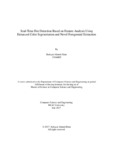| dc.contributor.advisor | Uddin, Jia | |
| dc.contributor.author | Khan, Rubayat Ahmed | |
| dc.date.accessioned | 2022-06-06T06:04:05Z | |
| dc.date.available | 2022-06-06T06:04:05Z | |
| dc.date.copyright | 2017 | |
| dc.date.issued | 2017-07 | |
| dc.identifier.other | ID 15166005 | |
| dc.identifier.uri | http://hdl.handle.net/10361/16908 | |
| dc.description | This thesis is submitted in partial fulfillment of the requirements for the degree of Master of Science in Computer Science and Engineering, 2017. | en_US |
| dc.description | Cataloged from PDF version of thesis. | |
| dc.description | Includes bibliographical references (pages 28-30). | |
| dc.description.abstract | This research proposes two effective real time fire detection techniques, based on video processing. The former technique is restricted to indoor conditions only while the later does not have such constraints. Both the proposed methods utilize prominent features such as flame color information and spatiotemporal characteristics to identify fire areas. For the first technique, color segmentation is carried out in the earliest stage to separate potential fire areas using the red component of RGB. Moving pixels are identified using frame differences from a reference frame followed by de-noising. In the next phase of the model, the growth of the segmented regions of the current frame is compared with later frames and based on the fact that a hazardous fire expands with time, regions with no or decreasing growth is removed. The complex boundary of fire (rotundity) is valuable information that aids in detection. In the last step, a feature vector is created with rotundity information and trained using a neural network. The proposed model is tested using a dataset containing a wide range of indoor lighting conditions and compared to a state of the art fire detection technique to confirm its effectiveness. The experimental results show that the proposed model performs better compared to the state of the art model in terms of accurate detection and computation time, yielding an average accuracy of 99.1%.For the second technique, the initial stage of the work extracts fire colored pixels using a set of enhanced rules on RGB. Fire pixels are dynamic and to detect these moving pixels a novel method is proposed in this approach. The final verification is done by examining the area of the extracted regions. A harmful fire will grow over time, thus if the area happens to increase, the region under focus is declared as fire. Experimental results show that the model put forward outperforms other state of art models yielding an accuracy of 97.7%. | en_US |
| dc.description.statementofresponsibility | Rubayat Ahmed Khan | |
| dc.format.extent | 30 pages | |
| dc.language.iso | en | en_US |
| dc.publisher | Brac University | en_US |
| dc.rights | Brac University theses are protected by copyright. They may be viewed from this source for any purpose, but reproduction or distribution in any format is prohibited without written permission. | |
| dc.subject | Fire detection | en_US |
| dc.subject | Static and dynamic features | en_US |
| dc.subject | Color segmentation | en_US |
| dc.subject | Foreground extraction | en_US |
| dc.subject.lcsh | Neural networks (Computer science) | |
| dc.title | Real-time fire detection based on feature analysis using enhanced color segmentation and novel foreground extraction | en_US |
| dc.type | Thesis | en_US |
| dc.contributor.department | Department of Computer Science and Engineering, Brac University | |
| dc.description.degree | M. Computer Science and Engineering | |

